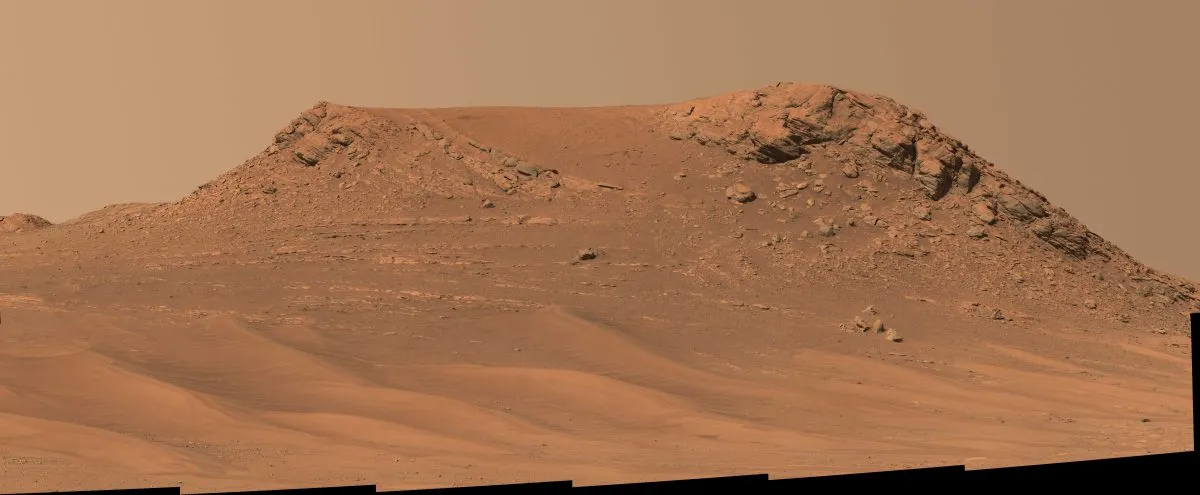The search for signs of life on Mars is one of the most exciting fields in planetary science.
No other planet has been visited by humanity's robotic rovers and spacecraft to the extent that Mars has.

These autonomous explorers are giving scientists new views of the Red Plane, discovering evidence of ancient lakes and river beds that hint at Mars's warmer, wetter past.
In March 2025, NASA announced that a team of scientists made an exciting discovery analysing rock that had been pulverised for study by its Curiosity rover.

These are the largest organic compounds on the Red Planet to date.
The findings were published in the Proceedings of the National Academy of Sciences and led by Caroline Freissinet, a specialist in astrochemistry and a researcher at the French National Centre for Scientific Research.
We spoke to Caroline to find out more.

Why is this Mars discovery so exciting?
We found large organic molecules composed of 10, 11 and 12 atoms of carbon.
These long, chain-shaped molecules – called alkanes – are very fragile.
They’re much more fragile than the ring-shaped (or ‘aromatic’) molecules made of carbon that we detected previously.
What this shows is that these long-chain molecules can be preserved over geological periods of time.
They were found on rocks that are 3.7 billion years old, which means they were deposited 3.7 billion years ago and preserved until today.
This has huge implications for the search for life on Mars, because we believe that, if life ever existed on Mars, it was around the same time that these molecules were deposited.

What are organic molecules?
By 'organic', we mean molecules composed of carbon and hydrogen.
The simplest of these is methane, which is one carbon atom and four hydrogen atoms.
We consider organic molecules to be a building block for life, but they can form independently of life.
So, the presence of organic molecules does not necessarily mean there is life, but life as we know it would require the presence of organic molecules to develop.
How do these long-chain carbon molecules relate to life on Earth?
We think the long-chain alkanes could come from long-chain fatty acids.
We believe that on the surface of Mars these fatty acids assemble themselves into vesicles – capsule-like structures.
That’s interesting because this might also be how life originated on Earth.
We can’t yet determine whether the organic molecules are formed from biotic or abiotic processes.
It’s possible that they come from chemical processes independent of life, or there may be a biological explanation.
What evidence do we need to confirm these molecules have biological origins?
Firstly, we would need to detect more molecules from the same family.
We’ve found molecules with 10, 11 and 12 carbon atoms, but we want to extend this to look for anywhere between eight and 18 carbon molecules.
The second thing is that, on Earth, there is a significant difference in the abundance of molecules with even and odd numbers of carbon atoms.
With just three types of molecules, it’s hard to spot a trend.
How did you make your discovery?
We used Curiosity, the rover that’s been exploring the surface of Mars since 2012, and part of an international collaboration between Europe and the USA.
Curiosity drilled for samples in the Gale crater in 2013, a 160km-wide (100-mile) area that was once home to an ancient lake around 3.7 billion years ago.
This lake would have housed all the ingredients for life: liquid water, organic molecules, mild temperature and pH, and energy sources.
It also had very good potential for preserving molecules because of the type of stone – mudstone – found in this region, which has layers of clay that can trap and essentially protect the organic molecules.

What did you do with the samples?
The region was so interesting that we kept some ‘doggy bags’ of samples that Curiosity had drilled.
Since that time, we’ve developed some new laboratory methods, which we implemented on the samples a couple of years after the drilling.
I found a unique peak on the spectra, corresponding to decane – the alkane with 10 carbon atoms.
After that, we did a lot of lab work to confirm our detection and extended the detection to undecane and dodecane (alkanes with 11 and 12 carbon atoms).
What’s next for your team?
There are many potential next steps – which is great!
In the short term, the remaining samples we have on Mars can still be tested once we have developed new methods.
In the medium term, there is the next mission to Mars, ExoMars, due to launch in 2028.
It’s due to dig two metres into Mars’s surface and would have the capability of distinguishing between the biotic and abiotic origins of the molecules.
Read the full paper at www.pnas.org/doi/abs/10.1073/pnas.2420580122
This interview appeared in the August 2025 issue of BBC Sky at Night Magazine
